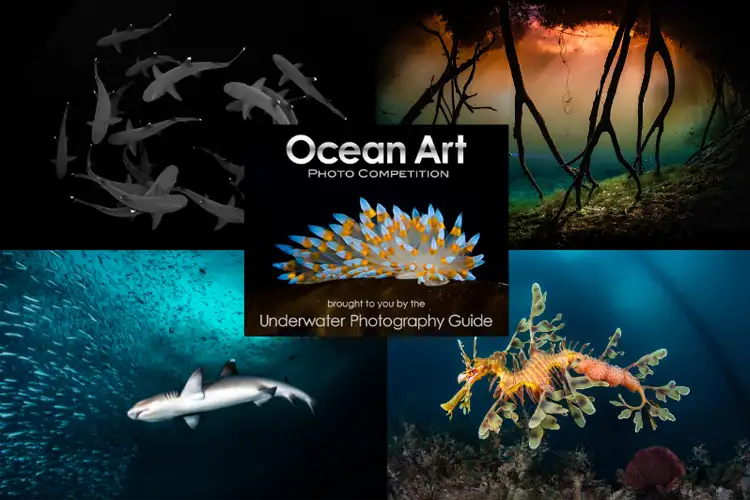
The winners of the 2024 annual Ocean Art underwater photo competition have been announced. The 13th iteration of the competition has seen record-breaking participation with thousands of entries received from more than 90 countries spread across 14 categories and competing for more than $60,000 in prizes.
The coveted Best in Show ranking was awarded to Eduardo Labat for his breathtaking image, ‘Dancing White Tips,’ taken at Roca Partida, Revillagigedo, Mexico. Labat’s photograph captured a synchronous ballet of white-tip reef sharks in the highly competitive Black & White category, and won him a five-day trip for two with seven dives with All 4 Diving at the Akaya Bali resort.
Equally competitive was this year’s Conservation category, with Dawn McDonald’s third-place image of a shark captured in a ghost net being a particular highlight. McDonlad’s image symbolises the devastating impact of abandoned, lost and discarded fishing gear or marine wildlife, and Ocean Art’s support for Ghost Diving, a charity dedicated to the removal of ghost gear and marine debris.
You may also like
- DIVE’s Big Shot Portraits – enter here!
- Insta360 X4: The best waterproof 360° action camera
- DIVE’s Biggest Shots of 2024
- Review: Alex Mustard’s 52 Assignments in Underwater Photography
- Jenny Stock’s guide to getting creative with your underwater photography
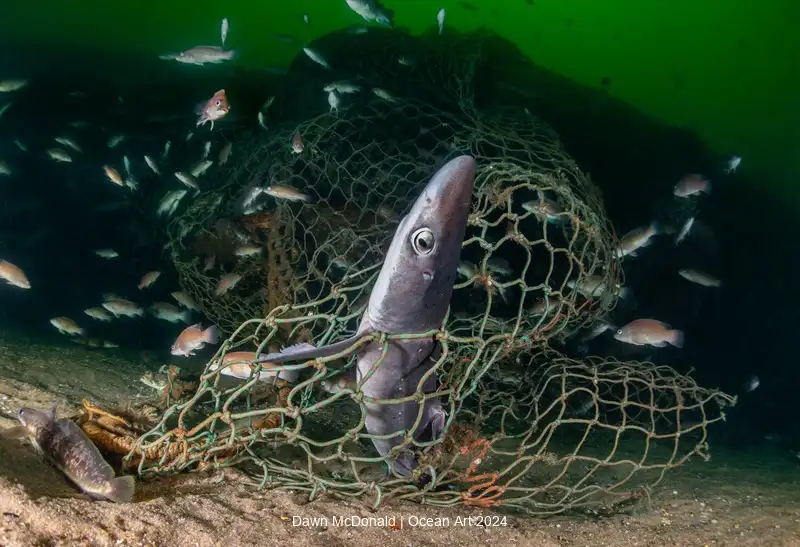
‘This year’s Ocean Art competition was nothing short of extraordinary,’ said Nirupam Nigam, organizer of the contest and President of Bluewater Photo & Editor-in-Chief of the Underwater Photography Guide.
‘The talent and vision displayed by our participants have set new benchmarks for underwater photography. These images do more than win awards; they captivate hearts and minds, reaching millions globally and reminding us of our shared responsibility to protect the ocean’s beauty. It’s an honour to see the competition grow in scope and impact every year.’
This year’s judging panel included world-renowned experts in underwater photography including Tony Wu, Marty Snyderman, and Mark Strickland. Canon and Marelux Ambassador Ipah Uid Lynn, also joined as a new judge, bringing a fresh perspective to the Underwater Digital Art and Underwater Fashion categories.
Check out the winning entries in each category below. A complete list of the winning photos, runners-up and honourable mentions can be seen on the Underwater Photography Guide’s Ocean Art 2024 Winners Page.
Best in Show and winner, Black & White Category
Eduardo Labat – ‘Dancing White Tips’

The Story: It was our last dive of the day, in the afternoon with sunlight fading. At Roca Partida, most white tip sharks congregate in small groups at various ledges throughout the rock formation. On this particular afternoon, a large aggregation of white tips started forming some distance from the rock. Dozens of sharks formed a tight group at an approximate depth of 25 feet. The sharks were not hunting or exhibiting aggressive behaviour.
After witnessing this rare event from the periphery of the formation, I slowly ascended to hover just above it. That is where I took this picture. From above, the sharks seemed to be swimming in synchrony in a circular motion. It was beautiful to witness.
I decided to use black and white for this picture both because of how the geometry of the formation looked in this style and also because of the natural contrast one can appreciate in black and white regarding the shark tips in relation to the rest of their bodies.
Location: Roca Partida. Revillagigedo, Mexico
Equipment Used: Sony A6600, Tokina 10-17mm F/3.5-4.5 Fish-eye lens, Nauticam Housing, Sea & Sea YS-D3 DUO strobes
Camera Settings: 1/160 sec, f4.0, ISO 640
1st Place Wide Angle
Hwanhee Kim – ‘Light‘
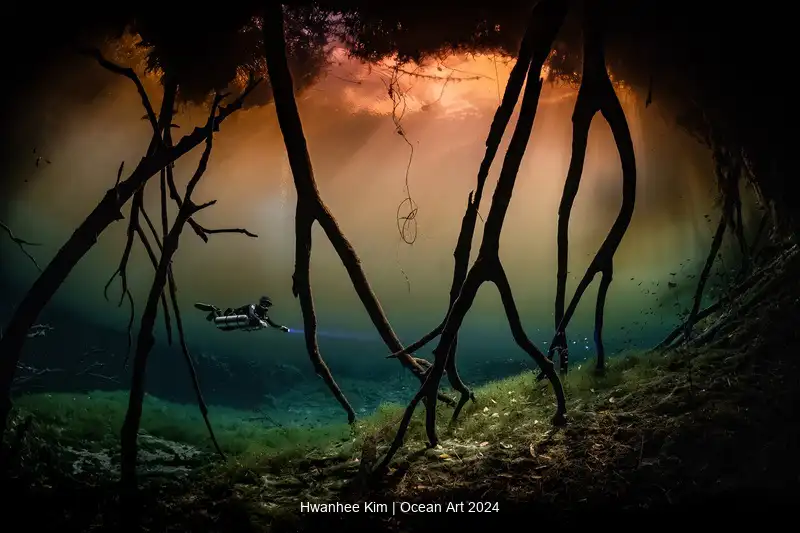
The Story: Light is nature’s greatest gift. The week before I captured this shot, heavy rains fell in Cancun. Sediment and nutrients from the nearby Carwash were washed into the cenote, creating stunning colours due to the difference in concentration.
Rain is typically a challenge for underwater photography, but in this instance, it produced vibrant hues rarely seen underwater.
Sunlight, with its strong vitality, pierced through the reddish waters, revealing a magical moment. The light served as a connection between the land and the underwater world, as well as between nature and humans. I felt privileged to witness this beauty and fortunate to have been able to document it.
Location: Mexico, Rancho Viejo, Carwash
Equipment Used: Camera – Nikon D850, Housing – Nauticam, Strobe/light – Natural Light, Wet Lens – Nikon 8-15mm
Camera Settings: ISO 1100, f/7.1, Shutter speed 1/125s
1st Place Macro
Adam Martin – ‘Juvenile Batfish‘

The Story: This juvenile batfish was found at 85′ depth in Tulamben, Bali, Indonesia. A snoot was used to try and isolate the flash to the subject, without lighting up too much of the background. The lighting highlights the texture and structure of the fish’s body, emphasizing its graceful lines and vivid colouration.
Location: Tulamben, Bali, Indonesia
Equipment Used: Sony A7RV w/ Canon 100mm Macro Lens Nauticam Housing, Inon strobe with snoot
Camera Settings: 1/250, f/13, ISO 320
1st Place Marine Life Behavior
Yoichi Sato – ‘Born From Mouth‘
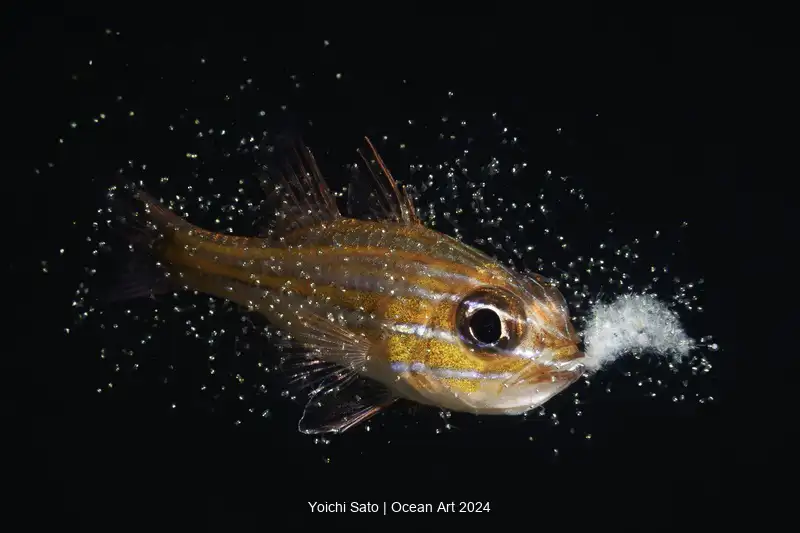
The Story: I was fortunate to capture the irreplaceable moment of a tiny creature hatching. On a midsummer night, while most creatures were fast asleep, a male Ostorhinchus properuptus, having completed a week-long incubation period, summoned all its energy and, with a trembling motion, released a swarm of larvae from its mouth.
To minimize stress on the fish, I observed the process under a dim red light. During the hatch-out moment, I used red lighting with a special setting that turned off the red light as soon as the strobe’s pre-flash was detected. This setup effectively eliminated red light interference in the photograph, ensuring the image captured the moment as naturally as possible.
Location: Minamisatsuma, Kagoshima, Japan
Equipment Used: Canon EOS R5, Canon EF-S 60mm, F2.8 Macro USM, Nauticam housing, 2x INON Z330, 1x RG Blue S02RE-SNC
Camera Settings: f/13, 1/125, ISO 400
1st Place Portrait
Stefano Cerbai – ‘Exceptional Shipping‘
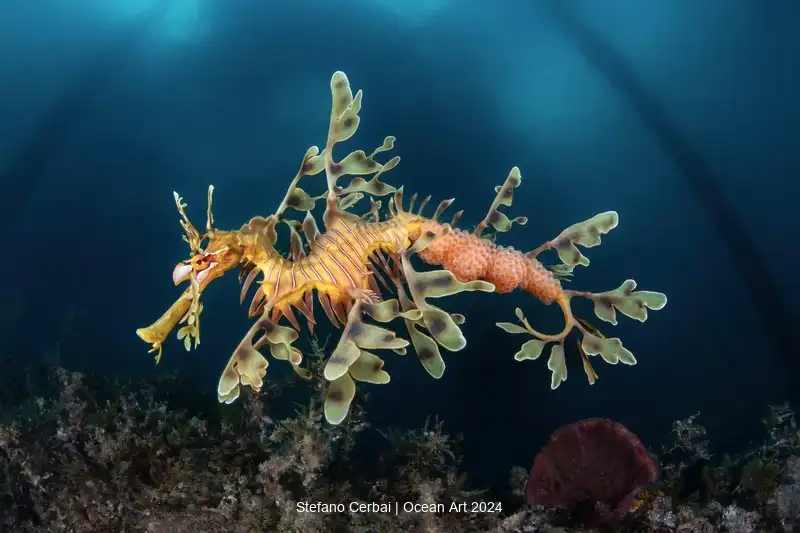
The Story: I was on my honeymoon in Australia, and among the many incredible places we visited was Southern Australia, where I had the chance to dive and search for the elusive sea dragon – an animal I had dreamed of seeing for years.
I was incredibly lucky not only to find and observe one but also to capture a photograph of it carrying its eggs, which it was protecting on its back near its tail. This unforgettable experience was truly a dream come true.
Location: Australia
Equipment Used: Nikon D7200, Isotta housing, Ikelite flash, Tokina 10/17mm
Camera Settings: 1/160, f16, ISO 250
1st Place Cold Water
James Emery – ‘Curious Cormorant‘
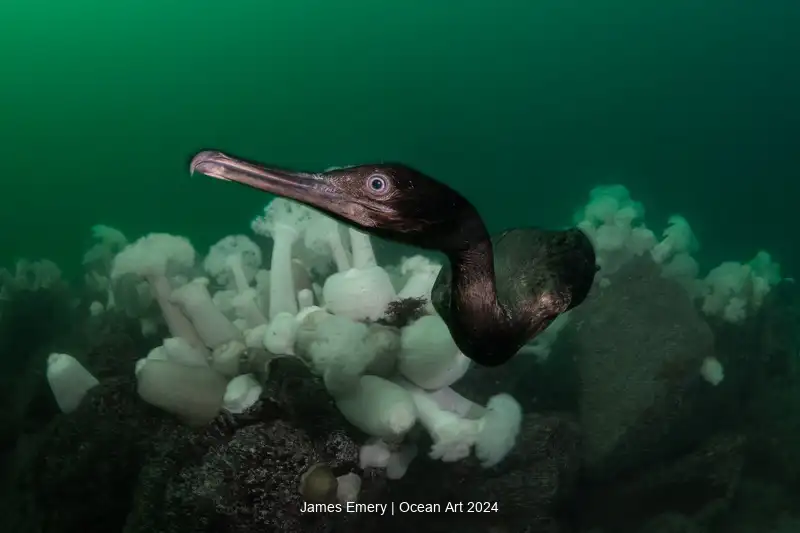
The Story: During a dive in Monterey, I was photographing the Metridium fields when I noticed a cormorant swimming down towards us. To my surprise, it began pecking at my wife’s head, but she was completely unfazed. I quickly swam over to get a few shots, and then the cormorant’s attention shifted to the reflection in my camera’s dome port.
It stayed with us for about 20 minutes, swimming up for air before returning to check us out again. It was a unique and playful moment that gave me a glimpse into the curiosity of the cormorant, and I was lucky enough to capture it.
Location: Metridium Fields, Monterey, California
Equipment Used: Sony a7iii, Nauticam housing, Canon 8-15mm with metabones adapter, Kraken KS160 strobes.
Camera Settings: f13, 1/80, iso 500
1st Place Nudibranchs
Borut Furlan – ‘Hooded nudibranchs‘

The Story: This was my first visit to Vancouver Island in October 2024 and my first visit to Canada at all. I didn’t have much knowledge about the area; therefore, I decided to use a wide-angle zoom lens on most of my dives because of its diversity.
It turned out that this was a good idea since I had the opportunity to photograph a wide selection of objects (except the smallest ones). When I reached the kelp forest with hooded nudibranchs, I was simply shocked. I have never before seen so many nudibranchs in one spot.
There were many thousands of them and they were everywhere, on the bottom, on the kelp and they were even swimming. I shot hundreds of various images of them and this one is one from this series.
Location: Port Hardy, Vancouver Island, BC, Canada
Equipment Used: Nikon D850, Nikkor 28-80/3.3-5.6 + Nauticam WACP (converted to Seacam), two Seacam 150D strobes
Camera Settings: ISO 400, f/14, 1/40s, 28mm
1st Place Blackwater
Kyungshin Kim – ‘Hunting‘
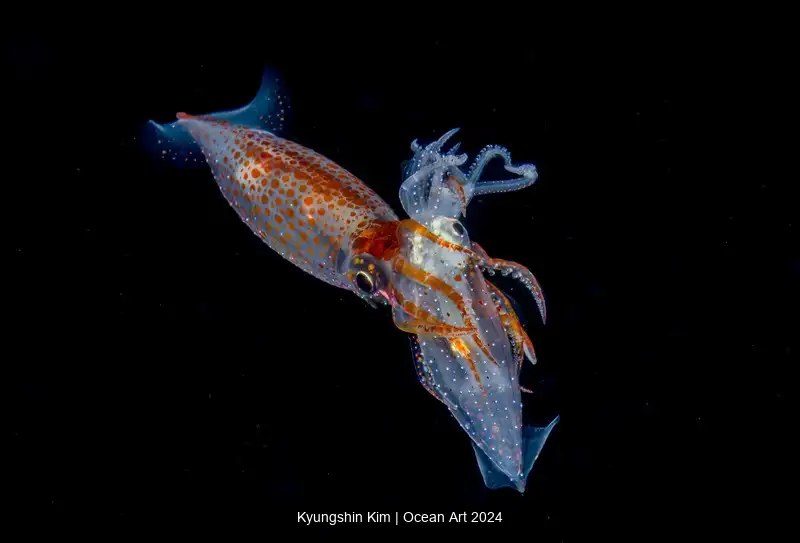
The Story: I captured this shot during a blackwater dive in Anilao last November. At first, I noticed two squids stuck together and assumed they were mating. However, upon closer inspection, I realized they were not mating, one squid was eating the other, a smaller squid.
Squids are known to engage in cannibalism, but it’s rare to witness small squids eating each other during a blackwater dive. I carefully followed and observed them, managing to capture a few photos. After about 10 minutes, the colour of the smaller squid, which was being consumed, began to fade. Finally, it released a spurt of black ink.
Shortly after, the squid that had finished eating slowly disappeared into the distance, while the squid that became its prey sank into the dark depths of the sea.
Location: Anilao, Philippines
Equipment Used: Nikon Z8, Nikon 60mm macro, Nauticam housing, 2 x Kraken S160, 1 x Weefine 5000 light
Camera Settings: f20, 1/200s, ISO 200,
1st Place Underwater Conservation
Kimber Greenwood – ‘Drowing in Plastic‘
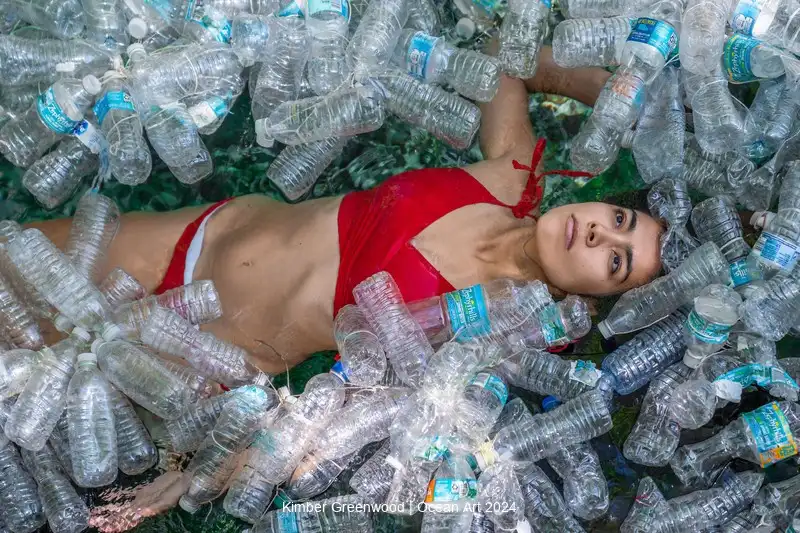
The Story: This image was created as part of an awareness project for the Florida Springs Council about the impacts of water bottling on the local Florida Springs. Over 300 bottles of water are produced every minute at water bottling plants such as the ones located just minutes from the Spring this image was shot at.
Not only are these bottles ending up in landfills and introducing microplastics into our environment, the bottling of ‘Spring Water’ is causing a loss of water from the Floridian Aquifer which is reducing water levels and water flow, allowing for deterioration of the Springs and rivers.
The bottles used for this image were donated by a local conservation activist who pulled them off the production belt of a local bottling plant. The images created from this campaign are used in ongoing social media and print advertising campaigns to encourage individuals to make a better choice to use reusable water bottles over plastic bottles that harm the local Florida environment in many significant ways.
Location: USA, High Springs, Florida, Jonathan Springs
Equipment Used: Sony A7IV, 24-70mm F2.8 GM,
Camera Settings: 70mm, f3.5, 1/500, ISO 400
1st Place Underwater Digital Art
Unkoo Kim – ‘Desire‘
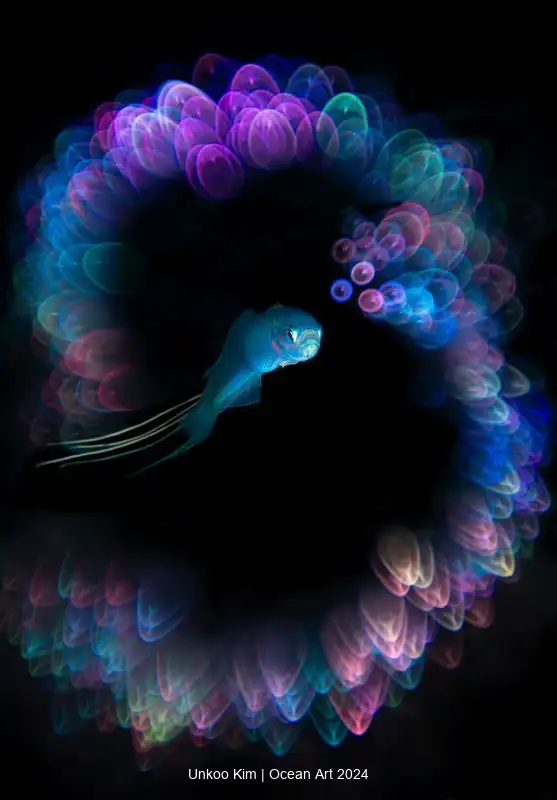
The Story: The sea at Seogwipo, where I captured this image, is a place close to my heart, filling me with warmth and cherished memories. However, it is far from an ideal environment for underwater photography. The water is often murky, and the currents are strong.
While other locations may face similar challenges, Seogwipo’s waters have been further impacted by rising sea temperatures, a lack of subjects, and other factors that make photography particularly difficult. I wondered, how could I create images that truly capture the beauty of the sea creatures inhabiting Seogwipo’s waters?
The idea of using light as a background to highlight these creatures came to mind, and I set out to convey the stunning beauty hidden within Seogwipo’s challenging waters. I took this image during the best season of the year. To capture a front-view image of the main subject, the Blue hana goby, I spent countless hours observing and getting close to them. Many shots had to be discarded along the way.
Imagining the dynamic interplay of the Blue hana goby with bokeh lights, I used tools I had prepared in advance and a modified vintage lens to combine multiple exposures with firework bokeh images. While capturing firework images is not particularly difficult, it requires meticulous preparation, effort, practice, and, most importantly, time to build a connection with the subjects.
Location: Seogwipo, Jeju Island, South Korea
Equipment Used: Nikon D850, Nauticam Nikon D850 housing, Ikelite DS230 * 2 & Sofirn Underwater lantern, Nikon 60mm macro lens / Bell & Howell Filmovara alteration
Camera Settings: f/11, 1/160, ISO 100
1st Place Underwater Fashion
Lucie Drlikova – ‘Long Live the Queen!‘
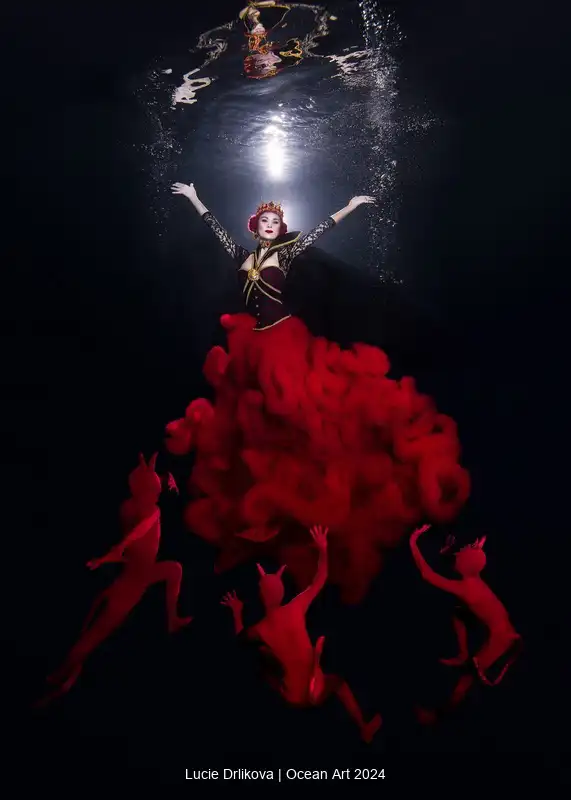
The Story: Underwater Photography of the Evil Queen, lifted by her demons, from the Snow White fairytale.
This photo is part of my personal project Once Upon a Dream in Waterland, which I’ve been working on for 7 years. This project represents a return to my childhood dreams.
All costumes, scenes and props are hand made by myself.
Location: Swimming pool, 8 metres deep, Aquapalace Praha, Czech Republic, Europe
Equipment Used: Nikon D810, lens Nikor 17/35 f2/8, Nauticam housing, strobes Subtronic
Camera Settings: Aperture f/8, shutter speed 1/160, ISO 500
1st Place Compact Wide Angle
Marco Lausdei – ‘Hunting in the Night‘

The Story: We are at one of the most famous night dive sites in the world: Maya Thila. I noticed a whitetip reef shark moving in cyclical patterns, visibly attracted to a cloud of silverfish positioned along the Thila drop-off. Using a nearby boulder for cover, I carefully hid and minimized my bubbles, trying to get as close as possible without disturbing the predator’s behaviour.
Once the shark grew accustomed to my presence, I waited for one of its cyclical movements to bring it within flash range. I timed the shot to capture not only the shark but also the evasive motion of the cloud of potential prey.
The shot was taken from a bottom-to-top angle, intentionally including the surface of the sea to add depth and dimension to the image. Understanding the subject’s habits and behaviour was essential to the success of this shot.
Location: Maldives – Fish head dive site
Equipment Used: Sony RX100m5, Seafrog housing, Seafrog dome
Camera Settings: ISO 200, f10, 1/160sec
1st Place Compact Macro
Naomi Springett – ‘Longnose Hawkfish‘
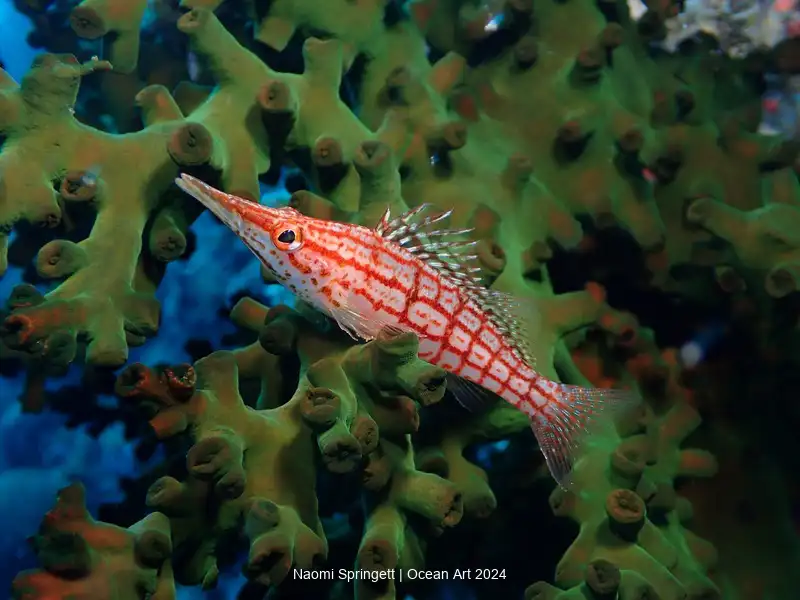
The Story: For our honeymoon, we joined a liveaboard dive trip to the Great Barrier Reef. This photo was taken on one of the nicest dives of the trip; a thriving coral bommie with abundant macro life.
Perched proudly on the black sun coral (Tubastraea micranthus), this longnose hawkfish (Oxycirrhites typus) was not too concerned with my presence and, much to my delight, sat still long enough for me to get a few photos before it swam away.
With so many tropical fish being camera shy, this was a rare treat. Black Sun Coral is among my favourite corals; the rich green colours provided a contrasting background for this striking fish, making this one of my favourite moments from a very special diving trip.
Location: Great Barrier Reef, Australia
Equipment Used: TG-4 with PT-056 housing, dual Sea and Sea strobes
Camera Settings: f/8, 1/40 sec, ISO-200, flash
1st Place Compact Behavior
Naomi Springett – ‘Mutualism‘
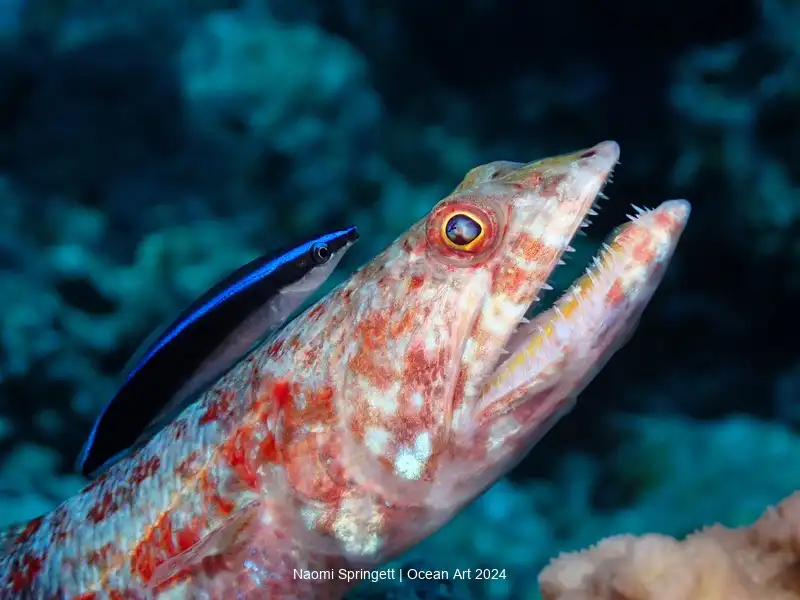
The Story: This bluestreak cleaner wrasse (Labroides dimidiatus) and variegated lizardfish (Synodus variegatus) were spotted on the Great Barrier Reef, Australia.
These fish are an example of mutualistic symbiosis, this means that both species benefit from their association with one another. The cleaner wrasse nibbles dead skin and parasites off the larger fish, providing the cleaner fish with food and leaving the lizardfish clean and healthy.
Usually, lizardfish are quite skittish, not tolerating photographers to get too close, but this individual was quite content to pose for photos during its clean. I was amazed to watch the smaller fish dart all over the lizardfish, even into its mouth, demonstrating incredible trust on the part of the smaller fish, eventually settling right on top of the lizardfish’s head!
Location: Great Barrier Reef, Australia
Equipment Used: TG-7 with PT-059 housing, dual Sea and Sea strobes
Camera Settings: f/13, 1/80 sec, ISO-200, flash
For more information about the Ocean Art contest and the Underwater Photography Guide, head to www.uwphotographyguide.com


